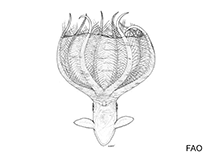Stauroteuthis syrtensis Verrill, 1879
Balloon octopod| Native range | All suitable habitat | Point map | Year 2050 |

|
| This map was computer-generated and has not yet been reviewed. |
| Stauroteuthis syrtensis AquaMaps Data sources: GBIF OBIS |
Google image | No image available for this species;
drawing shows typical species in Stauroteuthidae.
Classification / Names Common names | Synonyms | CoL | ITIS | WoRMS
Cephalopoda | Octopoda | Stauroteuthidae
Environment: milieu / climate zone / depth range / distribution range Ecology
Pelagic; depth range 250 - 4000 m (Ref. 1978), usually 1500 - 2500 m (Ref. 1978). Polar; 3°C - 3°C (Ref. 1987)
Distribution Countries | FAO areas | Ecosystems | Occurrences | Introductions
Northern Atlantic. Subtropical to polar.
Length at first maturity / Size / Weight / Age
Maturity: Lm ? range ? - ? cm Max length : 11.4 cm ML male/unsexed; (Ref. 1978); 9 cm ML (female)
Life cycle and mating behavior Maturity | Reproduction | Spawning | Eggs | Fecundity | Larvae
Main reference
References | Coordinator | Collaborators
Collins, M.A. and C. Henriques 2000 A revision of the family Stauroteuthidae (Octopoda: Cirrata) with redescription of Stauroteuthis syrtensis and S. gilchristi. Journal of the Marine Biological Association of the United Kingdom 80:685-697. (Ref. 1978)
IUCN Red List Status
(Ref. 130435: Version 2025-1)
CITES status (Ref. 108899)
CMS (Ref. 116361)
Threat to humans
Human uses
| FishSource |
Tools
More information
Max. ages / sizes
Length-weight rel.
Length-length rel.
Length-frequencies
Mass conversion
Abundance
Internet sources
BHL | BOLD Systems | CISTI | DiscoverLife | FAO(Publication : search) | Fishipedia | GenBank (genome, nucleotide) | GloBI | Gomexsi | Google Books | Google Scholar | Google | PubMed | Tree of Life | Wikipedia (Go, Search) | Zoological Record



